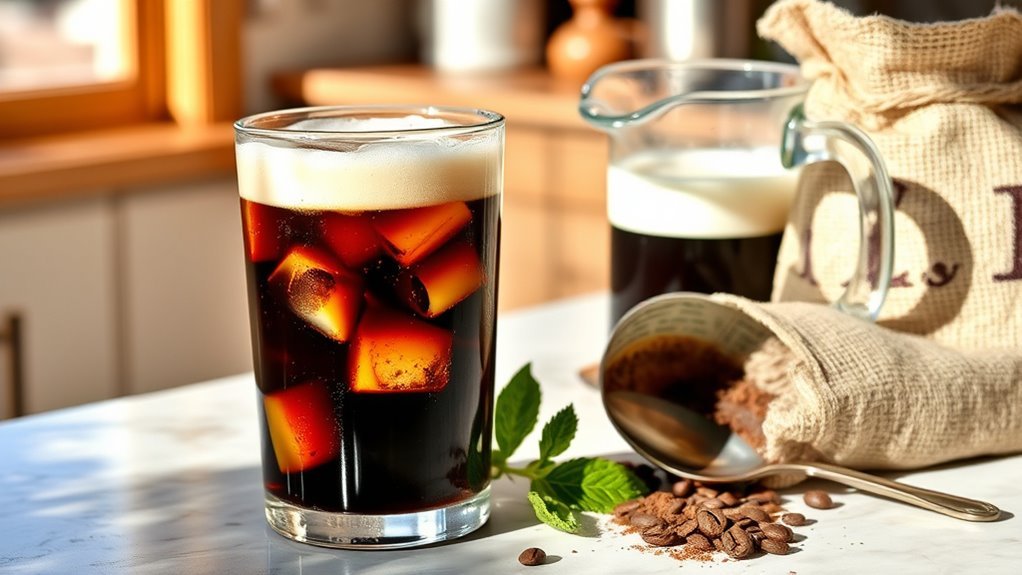How to Make a Perfect Iced Coffee at Home
To make perfect iced coffee at home, start with bold, medium to dark roasted beans like Sumatra or Colombian to keep flavor strong when chilled. Brew it stronger than usual using cold brew or pour over methods to avoid dilution. Cool your coffee quickly using coffee ice cubes or a shallow pan, and sweeten gradually with alternatives like stevia. Add whole milk or oat milk for creaminess. For more tips on enhancing your brew, keep exploring these simple techniques.
Choosing the Right Coffee Beans

When choosing the right coffee beans for iced coffee, you’ll want to focus on those with bold, rich flavors that won’t get diluted by ice. Opt for coffee bean varieties known for their robust profiles, like Sumatra or Colombian beans, which offer deep, earthy, and chocolaty notes. Medium to dark roasting levels are ideal, as they bring out caramelization and body, enhancing the coffee’s intensity even when cooled. Lighter roasts tend to lose their brightness and can taste flat once iced. By selecting beans with a strong character and the right roast, you maintain complexity and depth in your iced coffee, ensuring every sip feels vibrant. This knowledge lets you craft a revitalizing drink that matches your freedom to enjoy coffee your way.
Brewing Methods for Iced Coffee
A great iced coffee starts with the right brewing method, as it directly influences the flavor, strength, and clarity of your final drink. Cold brew is ideal if you prefer a smooth, less acidic cup. Steeping coarsely ground coffee in cold water for 12 to 24 hours extracts rich, mellow flavors without bitterness. On the other hand, pour over brewing offers precision and control. Using hot water poured slowly over medium-coarse grounds, it delivers a clean, bright cup with distinct nuances. When making iced coffee with pour over, brew it stronger than usual to compensate for ice dilution. Both methods grant you freedom to tailor your iced coffee’s profile—cold brew for mellow ease, pour over for vibrant clarity. Choose based on your taste and time preferences, and you’ll enjoy a perfectly brewed iced coffee every time.
Tips for Cooling Your Coffee Quickly
Three effective techniques can help you cool your coffee quickly without sacrificing flavor. First, try ice cube alternatives like coffee ice cubes made from brewed coffee or even frozen milk, which chill without diluting. Second, use rapid cooling techniques such as placing your hot coffee in a shallow metal pan to increase surface area, then refrigerate or freeze briefly—this speeds up heat dissipation. Finally, stir your coffee continuously while cooling; agitation accelerates temperature drop by distributing heat evenly. Avoid adding regular ice cubes directly; they water down your brew and weaken intensity. By applying these precise methods, you maintain the bold coffee essence while achieving the ideal chilled temperature swiftly, preserving your freedom to enjoy iced coffee anytime without compromise.
Sweetening and Flavoring Your Brew

Once your coffee has reached the perfect chilled temperature, enhancing its flavor with the right sweeteners and additives can elevate your iced coffee experience. You can start by choosing sugar alternatives like stevia, monk fruit, or agave syrup for a healthier twist without compromising sweetness. These dissolve easily in cold coffee, preventing any gritty texture. If you’re craving variety, flavored syrups offer a simple way to infuse your brew with notes of vanilla, caramel, or hazelnut—just a splash can transform your drink. Remember to add sweeteners gradually, tasting as you go, since cold coffee dulls sweetness compared to hot. This approach lets you customize your iced coffee freely, making every sip a perfect balance tailored to your palate.
Best Milk and Cream Options
Choosing the right milk or cream can dramatically change the texture and flavor of your iced coffee, so it’s important to contemplate both taste and consistency. If you prefer something classic, whole milk provides a creamy richness, while skim milk keeps it light. For a dairy-free twist, explore milk alternatives like oat, almond, or coconut milk; each offers unique nuances—from oat’s natural sweetness to coconut’s tropical flair. Cream thickness plays a key role too: heavy cream adds luxurious body and velvety smoothness, perfect if you want indulgence. Half-and-half strikes a balance with moderate thickness and flavor. Experimenting with these options lets you tailor your iced coffee to your freedom of taste—whether you want it silky, light, or boldly creamy, the right choice enhances every sip.
Creative Iced Coffee Recipes to Try
Anyone looking to elevate their iced coffee experience can experiment with creative recipes that blend unique flavors and textures. You can easily personalize your brew by adding flavored syrups or crafting invigorating iced coffee cocktails. Here’s a quick guide to inspire your next iced coffee creation:
| Recipe Name | Key Ingredients | Flavor Profile |
|---|---|---|
| Vanilla Almond Bliss | Espresso, almond milk, vanilla syrup | Smooth, nutty, sweet |
| Mocha Mint Cooler | Cold brew, chocolate syrup, mint leaves | Rich, invigorating, cool |
| Coconut Cream Dream | Iced coffee, coconut milk, caramel syrup | Creamy, tropical, sweet |
| Spiced Coffee Tonic | Espresso, tonic water, cinnamon syrup | Fizzy, spicy, bold |
Mix and match these elements to create your perfect iced coffee cocktail or a syrup-infused delight tailored to your taste.
Frequently Asked Questions
Can I Make Iced Coffee Without a Coffee Maker?
You can definitely make iced coffee without a coffee maker by exploring alternative brewing methods like cold brew or using a French press. Adjust the coffee strength by using more grounds or steeping longer to get a rich flavor. Simply brew your coffee, let it cool, then pour over ice. This freedom lets you customize your iced coffee exactly how you like it, without being tied to any machine.
How Long Can I Store Iced Coffee in the Fridge?
Think of your iced coffee as a fleeting summer breeze—best enjoyed fresh. For ideal freshness, you should store your iced coffee in an airtight container in the fridge. Following these storage tips, it’ll stay fresh for up to 3 to 5 days. Beyond that freshness timeline, the flavor and aroma start to fade, so it’s best to savor it sooner rather than later to keep that bold taste and freedom in every sip.
Is Iced Coffee Less Caffeinated Than Hot Coffee?
Iced coffee isn’t necessarily less caffeinated than hot coffee; it really depends on your brewing methods. If you brew your coffee strong and then chill it, the caffeine content stays similar. Cold brew, which steeps coffee grounds in cold water for hours, often has higher caffeine levels because of the extended extraction. So, you’ve got the freedom to control caffeine content by adjusting your brewing style, whether you prefer hot or iced.
What’S the Best Container for Storing Iced Coffee?
When storing iced coffee, you’ll want to choose containers that preserve freshness and flavor. Glass jars are ideal because they don’t absorb odors or flavors, keeping your coffee pure. Make sure they’re airtight containers to prevent oxidation and staleness, locking in that rich taste you love. Using these options lets you enjoy your brew freely, anytime, without worrying about it going flat or picking up unwanted smells in the fridge.
Can I Use Instant Coffee to Make Iced Coffee?
Think of instant coffee as the Swiss Army knife of your kitchen—versatile and ready whenever you need it. You can definitely use instant coffee to whip up iced coffee recipes, offering quick convenience and a consistent flavor. Instant coffee benefits include speed, minimal cleanup, and long shelf life, making it perfect for those who want freedom from complicated brewing. Just dissolve it in hot water, add ice, and customize with milk or sweeteners to suit your taste.






